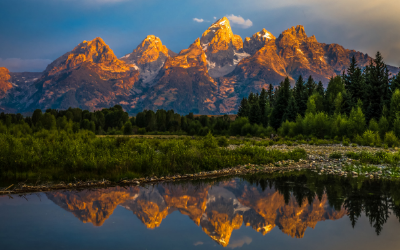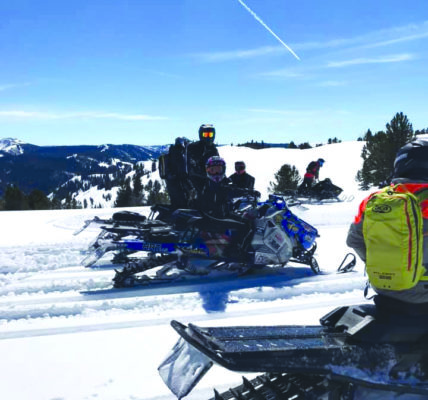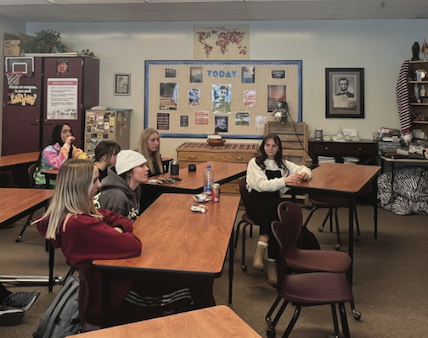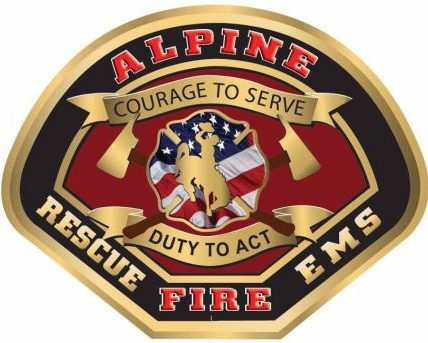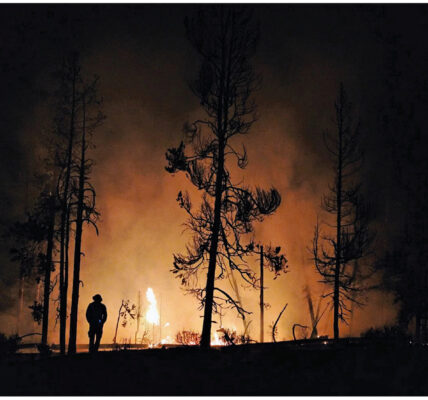By Angus M. Thuermer Jr., WyoFile.com
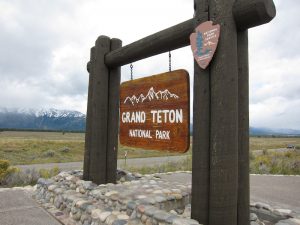
Officials and business leaders are warily eyeing the anticipated Memorial Day weekend opening of a gas station in Grand Teton National Park as a harbinger of returning tourism activity — the first opening of an in-park facility since Yellowstone and Grand Teton national parks closed in March.
What that potential milestone means for the surrounding communities, however, and how it should be managed, remains the subject of debate.
Grand Teton Lodge Company anticipates opening the Colter Bay Convenience Store near the shore of Jackson Lake in Grand Teton National Park on May 22, the company says on its website. The facility, located between Grand Teton’s community of Moran and Yellowstone’s South Entrance, can only be reached by passing through national park entrance stations that have been closed since March. The company anticipates opening the 300-plus site Gros Ventre Campground, also in Grand Teton, May 28.
“These dates may change and be modified in response to guidance from local, state and national health authorities, and in cooperation with the National Park Service and in line with the park’s phased resumption of operations,” Grand Teton Public Affairs Officer Denise Germann wrote in an email.
Concession operators in Yellowstone and Grand Teton national parks have posted other late-May and mid-June opening dates as they prepare for a phased approach to the coronavirus-stalled summer tourism season.
Yellowstone concessionaire Xanterra Travel Collection anticipates June 15 as the opening date for some of its properties, its website says. It operates most of the major lodges and cabins in Yellowstone, including hotels at Mammoth Hot Springs, Yellowstone Lake and Canyon.
With high season approaching, many questions remain about how officials will operate Wyoming landmark tourist destinations in the time of COVID-19.
“We haven’t finalized the plan,” Yellowstone Superintendent Cam Sholly wrote WyoFile on Sunday, “but what you will likely see is a phased approach, with limited facilities initially, then more facilities … if it’s safe to do so.”
“Our phased opening approach would limit the number of overnight accommodations initially until we see how things are going in the park, and in the states/counties around us,” he wrote. “Facilities would come online in a ‘limited’ manner initially, then expand slowly if safe to do so moving into the summer.
Whether the parks, Wyoming’s premiere tourism attractions, will open earlier for day visits remains uncertain, as does the shape and scope of the upcoming visitor season.
Regional business leaders agree the huge metrics of recent years — the 3.6-million-person
Nevertheless, there’s potential for a mini comeback, even in the face of reduced accommodations, smaller staffs and fewer services.
“Even though we may not get international visits, I think there is going to be a thirst for [domestic] travel,” Sholly said in a press call April 20. “Xanterra is telling us, at least in Yellowstone, their bookings are very strong through the summer.”
Gopaul Noojibail, Grand Teton’s acting superintendent, sees similar pent-up demand. “There might be an impact here earlier in the summer,” he said of the coronavirus pandemic, travel restrictions and other factors. But “the bookings for later in the summer are quite strong.”
Yellowstone and Grand Teton closed March 24 before their winter seasons were over. Keeping them open for the end of the season “was putting our communities at risk,” Sholly said.
That same worry will guide the re-openings, he said at the press call. “Safety is always going to be our governor,” he said, and resource protection another foremost thought.
Communities around the park agreed with the closing, Sholly said. But a growing number of calls come from those seeking to open the reserves, he said April 20.
“I expect those opinions will get much more divided,” he said.
Visitors each year spend more than $1 billion in economies within 60 miles of Yellowstone, he wrote.
“Many of our partners in gateways are stressed; they want to be safe and cautious, but also are feeling major economic strains. Their livelihoods are dependent on these parks being open.”
Coordination with regional health officials and community leaders is paramount, Sholly said. A key question is when communities are ready for an influx of visitors.
“It becomes more complicated when you start talking about 20,000 to 30,000 people a day,” in Yellowstone he said.
Park employee housing, frequently provided in close quarters, will be limited. In Grand Teton, that loss amounts to about 40% of workers’ beds, Noojibail said.
Last month Sholly was uncertain what would happen in places like Old Faithful, where hundreds of visitors crowd boardwalks each hour to witness the geyser’s eruptions. Is it the park’s responsibility to keep people apart, he wondered at the press call. Sunday he provided an answer.
“The NPS is not going to be the social distancing police,” he wrote. “We look to the visiting public, when we do open, to take responsibility for adhering to local, state, and national health guidance.”
Yellowstone is not talking about limiting park entrants with so-called visitor caps, Sholly said. The park will undertake “a conservative start, with a flexible plan that can ramp up quickly if conditions are favorable, or contract if they are not,” he wrote.
Coronavirus has had uneven effects on different gateways, contributing to varying views among communities regarding when Yellowstone should open.
Teton County has had 96 confirmed and probable cases as of May 1. During the same time, Park County has been virtually untouched.
“We have had one confirmed case that was in March,” said Greg Pendley, group sales coordinator for the Cody Cattle Company Dinner and Show. “We feel like we have done a good job and we’re ready for visitors.”
Meantime, Teton County has imposed some of the strictest health orders in the state and envisions many of them continuing through the middle of this month. Jackson Hole is scientifically different from the rest of the state, County Health Officer Dr. Travis Riddell said at a community briefing Friday. It has a higher positive test rate than Wyoming’s other 22 counties.
With its world-renown ski area, second-home community and cohort of international travelers, Teton County had more national and international visitors this winter than did Park County.
“Jackson Hole is clearly a year-round resort destination,” he said. Consequently, the higher rate of COVID-19 infection compared to Cody is understandable, he said.
Anna Olson, president and CEO of the Jackson Hole Chamber of Commerce, has watched the infection run through her community during a tourist season and even kill one “beloved” member.
Between Jackson and Cody, “there have been completely different experiences because of our winter,” she said. There is no doubt we’ve been through a round of it. We know what it looks like. It shut down our industry for four weeks. We have had a very hard experience.”
Pendley said those who have booked for the nightly Cattle Company dinner and show need to see Yellowstone. “They’re nervous about getting here and the park is not open,” he said. “If we can say the East Gate is open, you can enjoy Yellowstone and come back out and stay in Cody — that’s better than [saying] Yellowstone is closed, come see us anyway.”
Riddell said a good way to open would be to allow day trips only. “Day-use probably pretty effectively limits folks from outside,” he said. “It does have the potential to backfire — drawing more people into [gateway] communities.”
West Yellowstone, Montana, isn’t worried about being overwhelmed, said Marysue Costello, president and CEO of the town’s Chamber of Commerce. The state still has a 14-day quarantine order in place for visitors, she said, and that has to change first.
A major resort operator doesn’t anticipate opening before May 22, she said. “It’s not going to surprise people if it’s after the middle of May and even the first of June.”
“I don’t think at this point we’re worried about being overwhelmed,” she said.
West Yellowstone motels and hotels are well positioned for when visitors return, she said. “Everything in West Yellowstone has private baths.”
A limit of appropriate worker housing may well cap visitor occupancy, she said. Other factors may diminish room supply, she said, like the need to clean accommodations beyond what is normally done. There may even need to be a longer turn-around that puts each occupied room out of service for a day of cleaning, she said.
“We’re eager to see people come,” Costello said. “We want to give them the best experience they can have under what people are calling this new normal.”
“All the travel indicators are that travel will start locally and regionally,” said Jackson chamber leader Olson. “It’s the only place anybody will have any confidence.”
There’s a thirst for recreation in Wyoming, including along the border with Colorado where non-Wyoming residents are ignoring state health orders requiring visitors to quarantine themselves for 14 days, Olson said. Despite that, a dearth of overnight rooms will greatly diminish normal tourism, she said.
For the major national park concessionaires, “by far the majority of their lodging is going to be closed for the summer,” Olson said. Campgrounds and rental cabins — which may be easier than hotels to open and operate — are minor players in the overall scene, she said.
“I would agree there is a pent-up demand,” Olson said. “The combination of having a limited amount of lodging is going to have an impact on Jackson depending on when regional people start traveling.”
Host communities and businesses may try new strategies, such as promoting several-nights’ stay in one place rather than see guests hop-scotching from one regional hotel to another. Other uncertainties loom.
“What we don’t know is what the virus is going to do,” she said. “If there is a cluster somewhere … will it impact the decision to travel?” People won’t want to be far from home, she said, fearing they might become ill and stranded.
Most operators in the region appear to seek a simple, uniform message and an opening that does not stutter.
It would make sense for all the national park gates to open at the same time “to have that consistency and understanding,” Olson said. “That’s been indicated [by Yellowstone] that would be their preference too,” she said. “Nobody wants to see a stop-start. That will not serve us.”
Cody is aware that Teton County’s struggles with COVID-19 likely stemmed from national and international travelers, said Tina Hoebelheinrich, executive director of the Cody Country Chamber of Commerce. But there are more protocols in place and a greater awareness today than when the virus first struck Jackson Hole, she said.
“While we don’t want to open Pandora’s box, we feel if we look at the data, we are ready,” she said. “We definitely don’t want to open the floodgates and become a hot spot.
“That’s what’s so important about the staggered start,” she said. “You ease into it and give yourself an opportunity to correct.”
Teton County Health Officer Riddell warned that the novel coronavirus “is not going to go extinct anytime in our lifetime.” Instead, “it’s very likely we’ll have sort of a roller-coaster ride.
“We need to be prepared to manage the peaks as they come our way,” he said. At the same time, economic stress creates associated health impacts.
To unduly suppress visitation “is to kill off our community,” he said. “That is equally a public-health issue.”
Cody is not going to accept the existing condition and forsake its identity, Hoebelheinrich said. The prospect of losing 60% of the town’s businesses, “that’s something I don’t want to accept.”
WyoFile is an independent nonprofit news organization focused on Wyoming people, places and policy.

